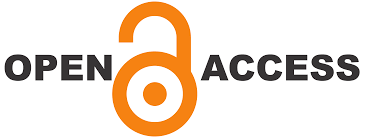Evaluation of Digital Learning Integration to Improve Junior High School Students' Digital Literacy
Keywords:
Digital Learning Integration, Junior High School, Digital Literacy, Mathematics EducationAbstract
This study examines the role of digital literacy in mathematics education, focusing on students’ learning experiences with the Pythagorean Theorem and Linear Equations. Digital literacy, which includes the ability to search, evaluate, and synthesize online information, is increasingly vital in supporting effective learning. A total of 60 students participated in face-to-face lessons supported by digital applications such as Photomath, Microsoft Math Solver, and Mathway. Data were collected through classroom observation, worksheet analysis, documentation of interactions with digital tools, semi-structured interviews, and a validated digital literacy questionnaire covering three aspects: information searching, content evaluation, and knowledge assembly. The findings show that students achieved a very high level in information searching (80%), while content evaluation (75%) and knowledge assembly (70%) were categorized as high. These results highlight the effectiveness of digital tools in facilitating quick access to problem-solving procedures, but also reveal the need to strengthen students’ ability to critically evaluate and reconstruct knowledge. In conclusion, digital literacy is essential for enriching mathematics learning, enhancing engagement, and deepening conceptual understanding. However, instructional designs must emphasize critical and reflective thinking so that students can move beyond passive use of technology toward becoming active, independent, and critical problem-solvers in the digital era.
Downloads
References
Aggarwal, D. (2023). Exploring the Scope of Artificial Intelligence (AI) for Lifelong Education through Personalised & Adaptive Learning. Journal of Artificial Intelligence, Machine Learning and Neural Network, 41. https://doi.org/10.55529/jaimlnn.41.21.26
Aksenta, A., Irmawati, Hayati, N., Sepriano, Herlinah, Silalahi, A. T., Pipin, S. J., Abdurrohim, I., Boari, Y., Mardiana, S., Sutoyo, Muh. N., Sumardi, Gani, I. P., & Ginting, T. W. (2023). LITERASI DIGITAL: Pengetahuan & Transformasi Terkini Teknologi Digital Era Industri 4.0 dan Sociaty 5.0. In Perspektif (Vol. 1, Issue 2).
Al Farabi, M. R. F., & Rohmah, Z. (2023). Teaching Multimodal Literacy Through Integrated Learning of Advertisement Texts. Journal of English Teaching, Applied Linguistics and Literatures (JETALL), 6(1), 73–88. https://doi.org/10.20527/jetall.v6i1.15340
Alfia, N., Sumardi, S., & Kristina, D. (2021). Integrating digital literacy into efl classroom: a study of the theory of planned behavior. JPI (Jurnal Pendidikan Indonesia), 10(3). https://doi.org/10.23887/jpi-undiksha.v10i3.29812
Alsowat, H. H. (2022). Hybrid Learning or Virtual Learning? Effects on Students’ Essay Writing and Digital Literacy. Journal of Language Teaching and Research, 13(4). https://doi.org/10.17507/jltr.1304.20
Amin, A. Muh., Adiansyah, R., & Hujjatusnaini, N. (2023). The Contribution of Communication and Digital Literacy Skills to Critical Thinking. Jurnal Pendidikan Sains Indonesia, 11(3). https://doi.org/10.24815/jpsi.v11i3.30838
Atin, S., Syakuran, R. A., & Afrianto, I. (2022). Implementation of Gamification in Mathematics m-Learning Application to Creating Student Engagement. International Journal of Advanced Computer Science and Applications, 13(7). https://doi.org/10.14569/IJACSA.2022.0130765
Caneva, C., & Pulfrey, C. (2023). Digital Capacity Building in Schools: Strategies, Challenges, and Outcomes. Médiations et Médiatisations, 13. https://doi.org/10.52358/mm.vi13.394
Damiati, M., Junaedi, N., & Asbari, M. (2024). Prinsip Pembelajaran dalam Kurikulum Merdeka. Journal of Information Systems and Management (JISMA), 3(2).
de Gamboa, G., Badillo, E., & Font, V. (2023). Meaning and Structure of Mathematical Connections in the Classroom. Canadian Journal of Science, Mathematics and Technology Education, 23(2). https://doi.org/10.1007/s42330-023-00281-2
De Vega, N., & Rahayu. (2023). Enhancing English Learning: Self-Determination in Indonesia Digital Classrooms. Inspiring: English Education Journal, 6(2). https://doi.org/10.35905/inspiring.v6i2.6611
Durmaz, B. (2023). The Use of Literary Elements in Teaching Mathematics: A Bibliometric Analysis. Journal of Teacher Education and Lifelong Learning, 5(1). https://doi.org/10.51535/tell.1232736
Edgel, T., McCarstle, S., Reyes, N., & Leibold, A. (2021). A Professional Development Workshop Using Digital Literacy to Build Students’ Self‐Efficacy and Sense of Belonging on Campus. Journal of College Academic Support Programs, 3(2). https://doi.org/10.36896/3.2pp2
Fatqurhohman, F. (2025). Transformasi Kepemimpinan Pendidikan Era VUCA: Strategi Menuju Institusi Unggul dan Adaptif. CV. Ihsan Cahaya Pustaka. ihsancahayapustaka.id
Fatqurhohman, F., & Huda, H. (2025). Implementation of Articulate Storyline Learning Media in Cultivating Students’ Character in The Digital Era. AULADUNA: Jurnal Pendidikan Dasar Islam, 12(1), 11–22. https://doi.org/10.24252/auladuna.v12i1a2.2025
Frison, D. (2023). Higher Education in Post-Covid19: The Digital Transformation of Work-Integrated Learning Programmes. https://doi.org/10.36253/979-12-215-0151-3.22
Hafizah, N. (2023). Media Pembelajaran Digital Generasi Alpha Era Society 5.0 Pada Kurikulum Merdeka. Al-Madrasah: Jurnal Pendidikan Madrasah Ibtidaiyah, 7(4). https://doi.org/10.35931/am.v7i4.2699
Hannigan, C., Alonzo, D., & Oo, C. Z. (2022). Student assessment literacy: indicators and domains from the literature. Assessment in Education: Principles, Policy and Practice, 29(4). https://doi.org/10.1080/0969594X.2022.2121911
Heryani, A., Pebriyanti, N., Rustini, T., & Wahyuningsih, Y. (2022). Peran Media Pembelajaran Berbasis Teknologi Dalam Meningkatkan Literasi Digital Pada Pembelajaran IPS di SD Kelas Tinggi. JURNAL PENDIDIKAN, 31(1). https://doi.org/10.32585/jp.v31i1.1977
Hidajat, F. A. (2023). Augmented reality applications for mathematical creativity: a systematic review. Journal of Computers in Education. https://doi.org/10.1007/s40692-023-00287-7
Huang, Z., Fey, M., Liu, C., Beysel, E., Xu, X., & Brecher, C. (2023). Hybrid learning-based digital twin for manufacturing process: Modeling framework and implementation. Robotics and Computer-Integrated Manufacturing, 82. https://doi.org/10.1016/j.rcim.2023.102545
Idhartono, A. R., & Badi’ah, L. I. (2022). Strategi Praktek Pembelajaran Kurikulum Merdeka. Kanigara, II(2).
Indefenso, E. E., & Yazon, A. D. (2020). Numeracy level, mathematics problem skills, and financial literacy. Universal Journal of Educational Research, 8(10). https://doi.org/10.13189/ujer.2020.081005
Jumriani, & Prasetyo, Z. K. (2022). Important Roles of Local Potency Based Science Learning to Support the 21 st Century Learning. European Journal of Formal Sciences and Engineering, 5(1). https://doi.org/10.26417/ejef.v1i1.p6-16
Kim, D., & Ryoo, D. (2023). Learning Techniques Using Study With Me: Focus on Motivational Orientations, Learning Competency, and Digital Literacy. IEEE Access, 11. https://doi.org/10.1109/ACCESS.2023.3312555
Kugler, E., & Kárpáti, A. (2023). Teaching Mathematics through art: Developing spatial skills and digital literacy of children with learning challenges through visual arts education. In Arts-Based Interventions and Social Change in Europe. https://doi.org/10.4324/9781003376927-6
Kusumastuti, F. A., & Priatna, B. A. (2020). Mathematics Literacy and Storytelling. The 2nd International Conference on Elementary Education, 2(1).
Lestari, H., & Rahmawati, I. (2020). Integrated STEM through Project Based Learning and Guided Inquiry on Scientific Literacy Abilities in Terms of Self-Efficacy Levels. Al Ibtida: Jurnal Pendidikan Guru MI, 7(1). https://doi.org/10.24235/al.ibtida.snj.v7i1.5883
Lim, F. V., & Tan-Chia, L. (2022). Multimodal Literacy Learning with Digital Texts. In Designing Learning for Multimodal Literacy. https://doi.org/10.4324/9781003258513-4
Magnusson, L. O. (2023). Digital technology and the subjects of literacy and mathematics in the preschool atelier. Contemporary Issues in Early Childhood, 24(3). https://doi.org/10.1177/1463949120983485
Mavlutova, I., Lesinskis, K., Liogys, M., & Hermanis, J. (2020). Innovative teaching techniques for entrepreneurship education in the era of digitalisation. WSEAS Transactions on Environment and Development, 16. https://doi.org/10.37394/232015.2020.16.75
Molin, L., & Godhe, A. L. (2020). Students’ critical analyses of prominent perspectives in a digital multimodal text. Nordic Journal of Digital Literacy, 15(3). https://doi.org/10.18261/issn.1891-943x-2020-03-02
Nisa, H., Isnaini, M., Utami, L. S., & Islahudin, I. (2023). Collaborative Learning Effect on Improving Students’ Creativity and Critical Thinking in the Independent Curriculum. AL-ISHLAH: Jurnal Pendidikan, 15(3). https://doi.org/10.35445/alishlah.v15i3.3538
Nopitasari, Banu Setyo Adi, Sugeng Riyanto, & Rahayu Condro Murti. (2023). Digital Literacy: Perceptions of Primary School Teacher Education Students. Jurnal Ilmiah Sekolah Dasar, 7(1). https://doi.org/10.23887/jisd.v7i1.48400
Reddy, P., Chaudhary, K., & Hussein, S. (2023). A digital literacy model to narrow the digital literacy skills gap. Heliyon, 9(4). https://doi.org/10.1016/j.heliyon.2023.e14878
Rochmawati, A., Wiyanto, & Ridlo, S. (2020). Analysis of 21 st century skills of student on implementation project based learning and problem posing models in science learning. Journal of Primary Education, 9(1).
Satar, M., Hauck, M., & Bilki, Z. (2023). Multimodal representation in virtual exchange: A social semiotic approach to critical digital literacy. In Language Learning & Technology (Vol. 27, Issue 2).
Shaghaghian, Z., Burte, H., Song, D., & Yan, W. (2022). Design and Evaluation of an Augmented Reality App for Learning Spatial Transformations and their Mathematical Representations. Proceedings - 2022 IEEE Conference on Virtual Reality and 3D User Interfaces Abstracts and Workshops, VRW 2022. https://doi.org/10.1109/VRW55335.2022.00155
Stoddart, A. L., & Selanders, K. P. (2022). Preparing for physical literacy: Exploring pre-service teachers’ training and understanding. Teaching and Teacher Education, 120. https://doi.org/10.1016/j.tate.2022.103886
Supriyadi, S. (2022). Hybrid Learning on Digital Literacy in The Implementation of Curriculum Merdeka. Jurnal Inovasi Pendidikan MH Thamrin, 6(2). https://doi.org/10.37012/jipmht.v6i2.771
Susantiningdyah, H., Kurnia, U., & Dirgantari, A. S. (2022). Multimodal Discourse Analysis on Mathematics Instruction: A Case Study in Indonesian Primary School. Englie: English Learning Innovation, 3(2), 164–178. https://doi.org/10.22219/englie.v3i2.22484
Tai, K. W. H., & Wei, L. (2021). Constructing playful talk through translanguaging in English medium instruction mathematics classrooms. Applied Linguistics, 42(4). https://doi.org/10.1093/applin/amaa043
Tytler, R., Prain, V., Kirk, M., Mulligan, J., Nielsen, C., Speldewinde, C., White, P., & Xu, L. (2023). Characterising a Representation Construction Pedagogy for Integrating Science and Mathematics in the Primary School. International Journal of Science and Mathematics Education, 21(4). https://doi.org/10.1007/s10763-022-10284-4
Upadhayaya, P. R. (2023). Information Communication Technology in Education: Bringing Innovation in Classroom. Ganeshman Darpan, 8(1). https://doi.org/10.3126/gd.v8i1.57335
van Garderen, D., Scheuermann, A., Poch, A., & Murray, M. M. (2018). Visual Representation in Mathematics: Special Education Teachers’ Knowledge and Emphasis for Instruction. Teacher Education and Special Education, 41(1). https://doi.org/10.1177/0888406416665448
Yanuari, N. F., & Turmudi, T. (2023). Critical thinking in mathematics education: A bibliometric analysis. International Journal of Trends in Mathematics Education Research, 6(2). https://doi.org/10.33122/ijtmer.v6i2.241
Zhu, X., & Evans, C. (2024). Enhancing the development and understanding of assessment literacy in higher education. European Journal of Higher Education, 14(1). https://doi.org/10.1080/21568235.2022.2118149
Downloads
Published
Data Availability Statement
Data sharing is not applicable to this article as no datasets were generated or analyzed.
Issue
Section
License
Copyright (c) 2025 Liony Margareta, Rina Avatus Marheni, Heni Purwitasari (Author)

This work is licensed under a Creative Commons Attribution-ShareAlike 4.0 International License.













